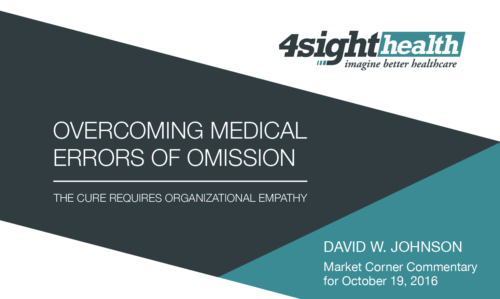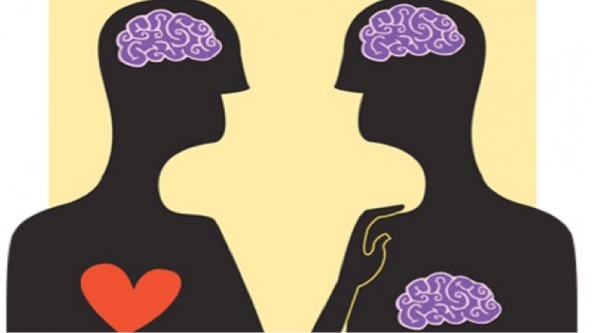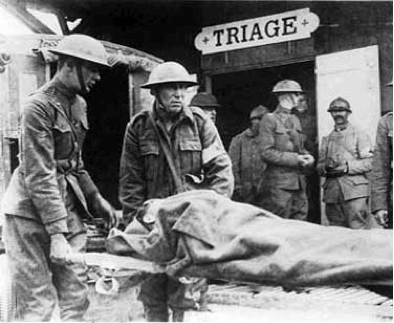October 18, 2016

Overcoming Medical Errors of Omission: The Cure Requires Organizational Empathy
Organizations fail or decline more frequently because of what they did not do than because of what they did. Russell L. Ackoff
Professor of Management Science
Wharton School, University of Pennsylvania
Organizational errors of omission occur when companies fail to undertake constructive actions that promote customer welfare. In medicine, omission errors harm and sometimes kill people. Payers deny life-saving treatments. Providers discourage vital second opinions. Patients languish in ignorance or powerlessness.
Cultural and economic factors exacerbate structural errors of omission within medicine. Physician education emphasizes individual responsibility for patient outcomes. Doctors, particularly specialists, believe they are their patients’ best hope for a cure. They resist treatment standardization, independent second opinions and patient transfers.
Still-predominate fee-for-service payment rewards activity over outcomes and neglects patient experience when reimbursing providers for treatments. Estimates of healthcare “waste” approximate $1 trillion[1] or 6% of the U.S. economy.
One trillion is a huge, incomprehensible number. A trillion seconds is almost 32,000 years – long before the first human civilizations. Wasting $1 trillion in healthcare spending is hard to do. It requires lots of good people doing bad things as well as many bad people doing very bad things (e.g. Medicare fraud).
Even worse than healthcare’s profligacy is its lack of empathy. In many, perhaps most, clinical settings, patient experience and treatment outcomes are secondary considerations. Revenue optimization is Job 1. American healthcare is not only expensive, it is difficult to navigate, often unfeeling and sometimes cruel.
The solutions for addressing healthcare’s stunted empathy lie within the ancient Hippocratic Oath: sharing knowledge; following scientific evidence; exhibiting compassion; putting patients’ needs first; acknowledging limitations and emphasizing prevention. Healthcare must go back to its future.

Structural Medical Errors of Omission
In Who Gets What – and Why, Nobel economist Alvin Roth describes how kidney exchanges have dramatically increased kidney transplant surgeries.[2] Sophisticated software matches kidney donors and recipients. An “altruistic” donor initiates the transplant chain. The recipient’s partner then donates a kidney to another diseased patient. The chain continues until a recipient’s partner is unwilling or unable to donate a kidney. This happens rarely.
According to Roth, hospitals limit the effectiveness of kidney exchange chains. Surgical centers create registries of potential kidney donors. Some kidney donors are easier to match. Centers “hoard” their easier-to-match donors, so they can perform and receive payment for related kidney transplant surgeries. The tragic result is fewer kidney transplants.
Kidney exchanges are just one of multiple examples where organizational prerogatives trump patient needs. It’s time for American healthcare to re-examine its priorities. Paraphrasing former Vice President Hubert Humphrey,
Healthcare’s true moral test is how it treats those in the dawn of life, the children; those in the twilight of life, the elderly; and those in the shadows of life, the needy.
How does U.S. healthcare do in these three categories?
- Dawn of Life: medical science has proven that pregnant women carrying to term (39 weeks) results in healthier babies and mothers. It also reduces complications and neo-natal ICU admissions. Yet, induced labor remains the rule rather than the exception in most hospitals. Few babies are born on weekends.
- Twilight of Life: 70% of people surveyed indicate a preference for dying at home. Nevertheless, 70% die in hospitals or long-term care facilities. Hospital and ICU admissions in the last six months of life are increasing.[3] 44% of Americans see 10 or more physicians in the last 6 months of life.[4] The end-of-life care treadmill is accelerating.
- Shadows of Life: S. healthcare dramatically under-invests in behavioral health, chronic disease management and preventive care. This under-investment falls disproportionately on economically-disadvantaged individuals and contributes to the double-digit life-expectancy disparity between America’s rich and poor.[5]

The Empathy Gap
While informative, aggregate statistics are antiseptic. Individual stories offer more compelling evidence of healthcare’s empathy gap. Here are three from my universe of friends and acquaintances:
- A friend’s father with pancreatic cancer was about to undergo Whipple surgery. A confident surgeon pressed to move forward even though he’d only performed 6 Whipple procedures and none of his patients had survived the operation. My friend transferred his father to M.D. Anderson where he underwent successful surgery.
- Another friend developed early-stage prostate cancer. His local surgeon recommended robotic surgery with likely loss of sexual function. Instead, he consulted a San Francisco specialist who performed less-invasive brachytherapy that cured him with no side effects.
- Under pressure from his oncologist son, a former health system CFO received a second opinion from Johns Hopkins on his bladder cancer. Turns out, the bladder cancer was actually a urethral carcinoma – different diagnosis and treatment.
The list goes on. Almost all Americans have similar stories. They illustrate clinical errors of omission. Clinical errors of omission are hard to detect. Poor subsequent outcomes are not even counted as medical errors.
Service errors of omission also occur regularly in healthcare. Excessive noise during diagnosis, treatments and recovery triggers stress and retards healing. Unclear directions, opaque pricing and excessive waiting can be confusing, frustrating and even demoralizing to patients.

Military Triage
In Better, author and surgeon Atul Gawande describes how the military reduced battlefield deaths during the Second Gulf War.[6] Despite medical advances, battlefield deaths had remained constant at roughly 25% of injured soldiers for fifty years. Focusing on outcomes and performance science reduced battlefield deaths to 10% during the Second Gulf War.
The military established sequential care levels with defined treatment protocols. Level 1 consisted of mobile “forward surgical teams with 20 caregivers that followed soldiers into battle. They stabilized wounded soldiers within minutes of injury. More seriously wounded soldiers transfer immediately to nearby modular “combat support hospitals.” After two-three days of treatment at these CSH facilities, soldiers with more advanced injuries transfer to “level IV hospitals” in Europe or the U.S.
Data was instrumental to performance improvement. Despite a chaotic environment and punishing hours, frontline caregivers kept injury, treatment and outcome logs with 75+ data fields for each casualty. Over time, patterns emerged that improved diagnosis, care protocols and recovery times.
Overcoming physician reluctance to transfer their patients was a major challenge. Gawande describes the “trust no one” mentality that permeates medical training. Gradually, military physicians accepted the new system. The average time from battlefield injury to advanced treatment in U.S. facilities dropped to 4 days from 45 days during the Vietnam War.
Focusing on patients and outcomes without bias clarifies the caregiving process. Meaningful data and evidence-based protocols reduce treatment variation and improve care delivery. This isn’t magic. It’s performance science.

Actual and Virtual Reality
Last month, I shared a long Uber ride with Jowoon Kim, a Korean software engineer. Her company OnComfort develops virtual-reality programs that help people manage stress. We were on our way to the Medicine X conference at Stanford where Jowoon was competing to win a prize for innovative patient-centric cancer care products.
Before long, I was wearing Samsung Oculus goggles and experiencing a soothing meditation routine called “Aqua.” I was underwater and modulating my breathing to a dolphin’s tailfin movement. I relaxed and sank into my seat.
OnComfort uses meditation programs to calm patients during chemotherapy sessions. Early evidence suggests these programs stimulate EDSO (endorphin, dopamine, serotonin and oxytocin) chemical release and promote healing. What a great idea.
When we arrived in Palo Alto, I left my smart phone in the Uber. Still relaxed fifteen minutes later, I called my Uber driver Romeo. He had left my phone with Felix at the hotel’s front desk – an incredible, uniquely San Francisco, experience.
The Medicine X conference emphasizes healthcare design and patient experience. Resident artist ask Yoko Sen asked attendees to identify the last sound they’d like to hear before dying.
Patients participated in all sessions and gave several TED-style presentations. The conference runs on empathy. It promotes inclusiveness and open-platform technology to advance medical discovery and healing.
Contrast this serenity and perspective with the jarring, chaotic jumble that most patients experience in hospitals. Consider the power of truly delivering patient-centered care.

Back to the Future
Modern medicine has lost its humility, its awe for natural healing and its reverence for humanity. High-tech interventions expand the frontiers of medical discovery while more people than ever suffer from chronic, debilitating conditions. Fragmented delivery and payment models cost too much, cause undue harm and foster unnecessary stress. Patients have become a means to higher revenues.
Hippocrates recommended that physicians serve “to help or, at least, to do no harm” to patients. Structural errors of omission don’t help patients and often cause harm. They inhibit effective transitions. They frustrate caregivers. They confuse, discourage and even demoralize patients.
Health companies must reinvent themselves to truly serve patients. All sick individuals deserve compassionate treatment, care navigators and independent second opinions. Care delivery should attend to the mind and the spirit as well as the body. Military medicine absorbed these truths and revolutionized its treatment capabilities.
“Patients First” is an ancient truth. Medicine cannot move forward until it recaptures that truth.
[1] http://healthaffairs.org/healthpolicybriefs/brief_pdfs/healthpolicybrief_82.pdf
[2] Alvin L. Roth, Who Gets What – and Why, Chapter 3 Lifesaving Exchanges, Houghton Mifflin Harcourt, 2016
[3] http://www.pbs.org/wgbh/pages/frontline/facing-death/facts-and-figures/
[4] http://www.dartmouthatlas.org/data/table.aspx?ind=17
[5] https://www.brookings.edu/wp-content/uploads/2016/02/BosworthBurtlessZhang_retirementinequalitylongevity_012815.pdf
[6] Atul Gawande, Better, Chapter 3 Casualties of War, Picador, 2007





